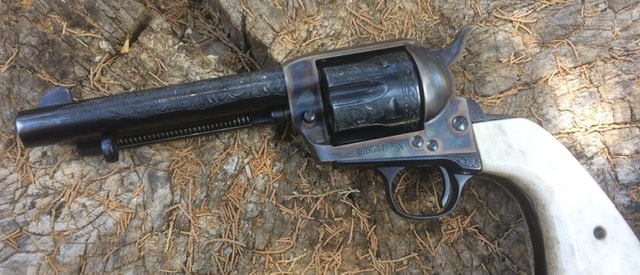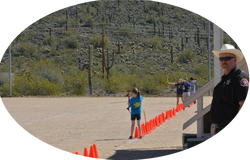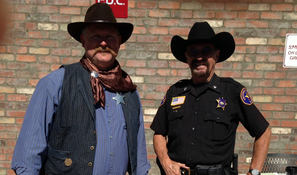In recent years independent and “print on demand” publishing has challenged the traditional publishing industry and opened a medium for thousands of “content creators” who self-publish and create their own work and make it available directly to their end consumer. Popular culture tells us that anyone can become a YouTube sensation and quit their day job to do what they love. Of course, very few actually get that kind of traffic and ad revenue, but the fact remains that the internet has produced a very decentralized publishing format for a variety of mediums. One such medium, aimed at fiction writers rather than video producers, is Wattpad.
0 Comments
 Many Colts get engraved and wear fancy stocks like elk horn Many Colts get engraved and wear fancy stocks like elk horn On April 28th of 2011, the Arizona State Legislature declared the venerable Colt Single Action Army (SAA) revolver as the Official State Firearm. While Sturm, Ruger firearms (who manufacture their single action Vaquero right here in AZ) might have preferred to get the nod, it makes perfect sense to award the designation to the old Colt model, as it was an important tool in establishing law and order on the southwestern frontier. The Colt SAA came out in 1873 as Colt’s most successful revolver in the then-new self-contained metallic cartridges, and sales to the Army quickly made this revolver a hot commodity. This was a wholly new model, replacing the 1872 Open Top that had been built on a rehashed design from the 1860 Army that had been one of the primary sidearms of the Civil War (which is still a fine weapon in its own right). The new SAA employed a solid top strap and a new, more powerful ammunition, the 45 Colt. Loading 35 grains of black powder underneath a 255 grain conical bullet, the 45 Colt boasted being the most powerful handgun cartridge of its day, and in fact this claim to power was not eclipsed until the advent of the .357 Magnum cartridge in 1935. Even afterwards, many big-bore aficionados, no less than the Dean of Sixguns, Elmer Keith, still preferred the old 45 to the new and modern 357, feeling that the mass and diameter of the bigger bullet outweighed the high velocity energy figures that the smaller round produced. Keith also noted that the SAA was the fastest gun of any design for getting the first shot out of the holster The Colt SAA has been made in three major “Generations.” The First Generation ran from 1873 to 1941, when handgun production for World War Two shut down production. Then the Second Generation ran from 1956 (taking advantage of the popularity of westerns and “fast draw” on TV) to 1974, when the original tooling was just too worn out to continue. They quickly retooled and began production of the Third Generation in 1976, and continue production in limited quantities. The Colt SAA, chambered in 45 Colt with a 5.5 inch barrel, was the official sidearm of the Territorial Arizona Rangers during their tenure from 1901 to 1909, which is perhaps the most compelling reason for it to be chosen as the official State Firearm. The Modern Rangers have since moved on to more contemporary semi-automatic pistols as their primary duty weapons, but even now individual Rangers can still qualify with the old thumb-buster and carry it on ceremonial duties. So slip out of your quarantine for a bit today and go burn some powder to celebrate the State icon!  Standing up for AZ Game and Fish Junior Archery Standing up for AZ Game and Fish Junior Archery For a society that is plagued with obesity and solipsism, we have a peculiar tendency to give shout-outs to the idea of sucking up our discomfort and forging ahead for the common good. This idea is called by many names, all linguistically related: Cowboy Up, Cowgirl Up, and my personal favorite, Ranger UP. This last one has been popularized by a clothing company of the same name, and in explanation they even put out a YouTube video to elaborate upon their claim. You can see it here (go ahead, I’ll wait.): https://www.youtube.com/watch?v=tjWmmye4-fM The primary point behind this video is that to ranger up to answer a call to service. The video is put out by former military, and former Army Rangers, but they include EMS, police/fire and others in their rubric for who is in a position to “ranger up,” and this rather broadens the scope of what sorts of people this might apply to. I Ranger Up, and I hope you do, too. Now, let me be absolutely clear, here. I am nobody's badass, and was never an Army Ranger – hell, the Navy told me to take a long walk off a short pier when I was 19, so not only was I not “special ops,” I was no “ops” at all. What I am is a middle aged English teacher with an expansive girth and wheezy sort of way of being in the world. But I Ranger Up just the same. How I do ranger up? I volunteer with the Arizona Rangers, which is an all-volunteer force dedicated to law enforcement support and community service. We help our community on at least three fronts. We perform duties that would otherwise be done by law enforcement, and thus reduce the cost to the state. We do a lot of private security-type duties, providing a uniform presence that helps keep the peace. Our clients donate to our cause, which enables us to donate literally thousands of dollars each year to children’s charities. We, as Arizona Rangers, are out there serving our communities in tangible ways. In our own way, we protect and serve. We are not police officers, and don’t fulfill the same role, but as ordinary citizens who choose to serve our communities, who choose to stand up – who choose to “Ranger Up.” How do you Ranger Up in your community?  The Author and Deputy State Commander Lt. Col. Rick Ellis discuss uniform standards, old and new. The Author and Deputy State Commander Lt. Col. Rick Ellis discuss uniform standards, old and new.
In the late nineteenth and early twentieth centuries, several western states had Ranger companies, mostly formulated on the model of the Texas Rangers, which were perhaps the first and are almost certainly the most famous. Colorado, New Mexico, California, and Arizona all had Ranger organizations. Virtually all of them are now defunct. The Arizona Rangers were founded in 1901 to combat rustling and lawlessness that was giving the territory a bad reputation and stood in the way of the territory’s bid for statehood. The rangers, 26 men in all, were tasked with law enforcement over the entire territory. They mostly worked alone, often undercover, and had to provide all their own equipment. It was a tough way to make a living. The Arizona Rangers don't get nearly the publicity of their Texas brethren, probably due to their short tenure, although Bill O’Neil did write a fine history of the Rangers; see the link below. They were disbanded in ’09, having either arrested or chased off most of the real rowdies, and Arizona came to statehood in 1912. The territorial rangers moved on to other work, but in 1957 several of them decided they saw a need for a community service organization, and they reformed the Arizona Rangers as an all-volunteer law enforcement auxiliary. The new Arizona Rangers have been serving their respective communities and raising and donating money to children's charities ever since. Today they are a recognized 501(c) (3) non-profit organization with four goals: 1. Render aid and assistance to law enforcement when called upon 2. Provide support for youth organizations 3. Support community activities that benefit all involved 4. Keep alive the traditions of the old west I am proud to be associated with the Arizona Rangers, serving my local community and raising money for our children. |
AuthorJoin me as I postulate about literature, popular culture, martial arts, and who knows what else. Archives
July 2021
Categories
All
|
 RSS Feed
RSS Feed
